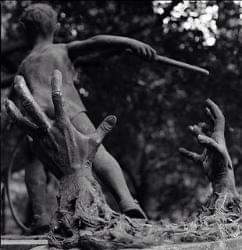Execution Dock at Wapping.
The High Court of Admiralty had jurisdiction over civilian crimes committed at sea and directly offshore and was established by Edward III circa 1360. It tried cases of murder, piracy and prizes (ships and goods captured at sea) and was presided over by one admiral by the early 15th century.
It had a Marshall and court officers and sat at the Old Bailey.
By the 16th century it had responsibility for trying all crimes that were committed at sea or along the English coast outside the borders of individual counties, involving English merchant ship’s crews but not Royal Naval seamen.
It functioned as a criminal court up to 1834 when this role was transferred to the Central Criminal Court, however it continued to try cases involving shipping, collisions, and salvage. The Judicature Acts of 1873 and 1875 saw the High Court of Admiralty merged with the other courts of England into the High Court of Justice.
In its role as a criminal court it dealt with capital cases such as murder at sea, mutiny and piracy and those sentenced to death by it were hanged at Execution Dock (rather than Tyburn or Newgate). This was located between Wapping Old Stairs (off Wapping High Street) and Wapping Dock Stairs in east London. The gallows was erected on the foreshore at low tide and executions were timed to fit in with low tide.
For instance that of Captain John Sutherland was postponed from Monday to Thursday, the 29th of June 1809 because of the tides.
Condemned prisoners were brought from Marshalsea Prison in Southwark, across London Bridge, and past the Tower of London to Execution Dock. Some prisoners were housed in Newgate prison and they went via Cornhill, Whitechapel Road and Commercial Road to Wapping.
The procession to the gallows was led by the Marshal on horseback (or his deputy) carrying a silver oar, representing the authority of the Admiralty. The prisoner travelled in a cart with a chaplain and the hangman (normally the civilian executioner who officiated at Tyburn and Newgate). Crowds lined the shoreline or hired boats moored in the Thames to get a better view of the proceedings.
Hangings were carried out in the same way as on land and in later times a “New Drop” gallows was used. After execution the body(s) were chained to a stake at the low water mark and left there until three high tides had washed over them. Somewhere between 1786 and 1814, this practice ceased.
In particularly serious cases of piracy the court could order gibbeting after execution in which case the body was covered in pitch and gibbeted lower down the Thames on the Isle of Dogs or Bugsby's Hole or Reach near Blackwall, as a deterrent to passing merchant sailors. (Gibbeting ceased in 1834 for civil and nautical crimes).
In cases of murder, after 1752, the court would order dissection (the same as for civilian murders). The criminal was taken down from the gallows when the tide had come in far enough for the water to touch his feet before being removed and sent to Surgeon’s Hall. Just as in the procession to Tyburn, those prisoners going to Execution Dock were allowed to stop for a drink and the landlord of The Turk's Head pub supplied them with a quart of ale.
Between 1735 and 1830 there were 78 confirmed executions and 4 probable ones, as detailed at http://www.capitalpunishmentuk.org/edock.html











Comments
Post a Comment